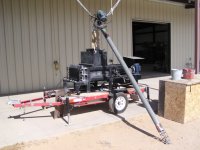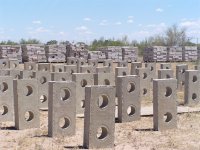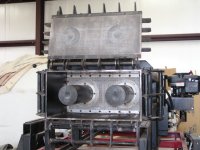thinksabunch
Member
I’ve converted a hydraulic log splitter into a block press – see pictures of press. The blocks are made from paper pulped in water with a hardener added – see picture of blocks. The hydraulic cylinder (pushing a big rectangular piston) presses a block by going through the following steps - starting from the fully retracted position:
1.1) Mix is dropped in a preweighed batch through the top of the press via an auger (picture) to a location just in front of the piston
2.2) The cylinder starts moving forward at a (higher) speed until the mix is entirely enclosed in the pressing box – the mix is being squeezed between the front of the piston and the inside of the front door of the press
3.3) Then the cylinder is slowed to another speed (by half or more), but still moving forward – we’re squeezing out water slowly while pressing the pulp into a block
4.4) Then the cylinder is stopped because it has reached a position in the press where the block is four inches thick – pressing is done
5.5) Then the cylinder is reversed about an inch and
6.6) stopped to take pressure off the front door
7.7) The front door is opened
8.8) Then the cylinder is directed to press forward again and it pushes the block out of the press four inches – the piston actually almost totally exits the front door of the press
9.9) Then the cylinder is instructed to fully retract as fast as it can
1110) During retraction, as soon as the piston is inside the front of the press , the door is closed
1111.) The piston quickly reaches its fully retracted position and the process starts over again.
A proportional solenoid-operated hydraulic valve can handle forward, stop, reverse and speed changes of the hydraulic cylinder, but what Is the best approach to take with a PLC? Right now we’re performing these steps manually and throughput is slooow. Is there a way to set up timers, limit switches or some other method? A rod connected to the rear of the piston protrudes through the back of the press and moves back and forth with the piston. So it would be possible to set up limit switches where appropriate in the sequence - but I would prefer to do it in a way that doesn’t depend on many externally mounted parts or switches - because of vibration, weather, exposure to damage, etc. All of this is done outside in the weather.
So, I would very much appreciate your advice on the best way to approach this problem.
Thanks.
Barry



1.1) Mix is dropped in a preweighed batch through the top of the press via an auger (picture) to a location just in front of the piston
2.2) The cylinder starts moving forward at a (higher) speed until the mix is entirely enclosed in the pressing box – the mix is being squeezed between the front of the piston and the inside of the front door of the press
3.3) Then the cylinder is slowed to another speed (by half or more), but still moving forward – we’re squeezing out water slowly while pressing the pulp into a block
4.4) Then the cylinder is stopped because it has reached a position in the press where the block is four inches thick – pressing is done
5.5) Then the cylinder is reversed about an inch and
6.6) stopped to take pressure off the front door
7.7) The front door is opened
8.8) Then the cylinder is directed to press forward again and it pushes the block out of the press four inches – the piston actually almost totally exits the front door of the press
9.9) Then the cylinder is instructed to fully retract as fast as it can
1110) During retraction, as soon as the piston is inside the front of the press , the door is closed
1111.) The piston quickly reaches its fully retracted position and the process starts over again.
A proportional solenoid-operated hydraulic valve can handle forward, stop, reverse and speed changes of the hydraulic cylinder, but what Is the best approach to take with a PLC? Right now we’re performing these steps manually and throughput is slooow. Is there a way to set up timers, limit switches or some other method? A rod connected to the rear of the piston protrudes through the back of the press and moves back and forth with the piston. So it would be possible to set up limit switches where appropriate in the sequence - but I would prefer to do it in a way that doesn’t depend on many externally mounted parts or switches - because of vibration, weather, exposure to damage, etc. All of this is done outside in the weather.
So, I would very much appreciate your advice on the best way to approach this problem.
Thanks.
Barry





